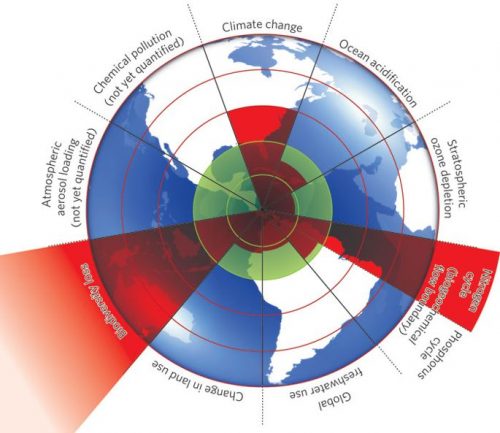Implementing global changes in food production and consumption.
Of all the apocalyptic scenarios one can imagine—war, disease, explosion of the sun—one that may not come to mind is humanity’s food system.
Some models predict that our robust food system, which feeds billions of people, may cause enough environmental destruction to destabilize the Earth’s ecosystem. Planetary boundaries that determine ecosystem stability, such as freshwater use and ocean acidity, may be pushed beyond their limits by our food system as soon as 2050. However, improvements in diet, technology, and food waste can mitigate these destructive environmental effects.
By 2050, researchers predict that the Earth’s population will double and income levels will triple. The larger, wealthier population will not only eat more food overall, but also consume more animal products. This could cause humanity to exceed planetary boundaries, causing the environment to lose self-regulatory functions.
“There is no sharp cut-off that defines the boundaries, and the timing and degree of harm depend on how far beyond the boundaries we go,” said Walter Willett, Professor of Epidemiology and Nutrition at Harvard University and one of the authors of the study.
If the food system continues its current path, Willett adds, it could create a cycle of further destruction. “We would enter an area of likely adverse effects on human health and the ability of the earth’s ecosystems to support adequate amounts of healthy food for future generations,” Willett said.
However, the study authors believe that these effects are avoidable with the combination of three major changes in our food production system: adoption of a plant-based diet, improved agricultural practices, and minimizing food waste.
The researchers created models with medium and high-ambition scenarios for these changes and calculated the expected environmental impacts. Impacts were quantified in terms of five metrics of environmental health: climate change, land use, freshwater use, and nitrogen and phosphorous application.
Normally, the production of animal products generates three-quarters of overall greenhouse gas emissions from agriculture. In a high-ambition improvement scenario, widespread adaptation of a mostly plant-based, “flexitarian” diet would decrease greenhouse gas emissions by as much as 56 percent, and the other four metrics by 6 to 22 percent, compared to the 2050 baseline projection. Even the adaptation of a medium-ambition dietary change, a more balanced diet than the typical American diet, would reduce greenhouse gas emissions by 29 percent.
Technological and agricultural changes include improving utilization of rainwater and feed changes to reduce methane production in livestock. Methane is responsible for 16 percent of global greenhouse gas emissions, and the concentration of methane in the air has increased by 10 times over the past decade—primarily from livestock production. Technological changes alone could reduce environmental impacts by 3 to 30 percent in the medium-ambition scenario, and 11 to 54 percent in the high ambition scenario.
Finally, the reduction in food loss and waste will reduce the amount of food that needs to be produced in the first place, reducing all relevant environmental impacts. These changes can be implemented in multiple ways, from ramping up education campaigns to improving food packaging and labeling.
If all measures of medium-ambition were combined, total environmental pressures could be reduced 25 to 45 percent. If measures of high-ambition were combined, total impacts could be reduced from 30 to 60 percent.
“It is possible to feed the people of our world a healthy and sustainable diet, but we are currently far off track to achieve this,” Willett said. But if we can improve the food system, he added, the health and viability of feeding humans in the future would be drastically improved.

